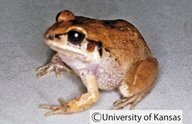|
Craugastor occidentalis (Taylor, 1941)
Western Leaf-litter Frog, Taylor's Barking Frog Subgenus: Craugastor | family: Craugastoridae genus: Craugastor |
| Species Description: Taylor, E.H. (1941) Some Mexican frogs. Proceedings of the Biological Society of Washington, 54 87–94. | |
 © 2010 Division of Herpetology, University of Kansas (1 of 8) |
|
|
|
Description Craugastor occidentalis can typically be differentiated from all other members of the C. rhodopis Species Group by a distinctive ‘Y-shaped’ supratympanic fold that extends onto the lateral surfaces of the dorsum (Streicher et al. 2014). Individuals of this species typically possess a supratympanic dark stripe or patch. Dorsal ground color occurs in varying shades of grey, tan or brown. Extensive lip barring is common. Some individuals have a thin mid-dorsal stripe, white arms and/or a distinctive white upper labium. Bright red coloration on the axial and postaxial thigh surfaces has been observed in an individual from Guerrero (Streicher et al. 2014). Males often had dark throats and proportionally larger tympana than females (Streicher et al. 2014). Distribution and Habitat Country distribution from AmphibiaWeb's database: Mexico
Life History, Abundance, Activity, and Special Behaviors Larva Trends and Threats Relation to Humans
Comments Phylogenetic analyses of C. occidentalis have revealed evidence of a phylogeographic break in the species. The break between two divergent clades of C. occidentalis occurs more or less at the terminus of the Trans-Mexican Volcanic Belt (TMVB) in western Jalisco (Streicher et al. 2014). As such, the TMVB may have been a dispersal filter barrier for C. occidentalis, a finding that is consistent with patterns observed in other amphibian species inhabiting both sides of this geological boundary (e.g. Smilisca fodiens; Cox et al. 2012). This species was originally described by Boulenger (1898) as Borborocoetes mexicanus. It was determined that a replacement scientific name was necessary because a different species in the same genus described earlier by Brocchi (1877) used the same specific epithet, mexicanus. Taylor (1941) provided the replacement name, Eleutherodactylus occidentalis, and is therefore credited as the species authority. Parasites have been described from a population in Jalisco (Martínez–Salazar 2008). References Boulenger, G.A. (1898). Fourth report on additions to the batrachian collection in the Natural-History Museum. Proceedings of the Zoological Society of London 1898, 473–482. [link] Brocchi, P. (1877). Sur quelques batraciens raniformes et bufoniformes de l’Amérique Centrale. Bulletin de la Société Philomathique de Paris. 1(7), 175–197. [link] Cox, C.L, Streicher, J.W., Sheehy III, C.M., Campbell, J.A. and Chippindale, P.T. (2012). Patterns of genetic differentiation among populations of Smilisca fodiens. Herpetologica 68, 226–235. [link] IUCN SSC Amphibian Specialist Group. (2020). Craugastor occidentalis. The IUCN Red List of Threatened Species 2020: e.T56801A3050260. https://dx.doi.org/10.2305/IUCN.UK.2020-3.RLTS.T56801A3050260.en. Accessed on 28 November 2023. Martínez–Salazar, E.A. (2008). A new rhabdiasid species from Craugastor occidentalis (Anura: Brachycephalidae) from Sierra de Manantlan, Jalisco, Mexico. Revista Mexicana de Biodividad 79, 1. [link] Taylor, E.H. (1941) Some Mexican frogs. Proceedings of the Biological Society of Washington 54, 87–94. [link] Streicher, J.W., García-Vázquez , U.O., Ponce-Campos, P., Flores-Villela, O., Campbell, J.A. and Smith, E.N. (2014) Evolutionary relationships amongst polymorphic direct-developing frogs in the Craugastor rhodopis species group (Anura: Craugastoridae). Systematics and Biodiversity 12(1), 1–22. [link] Originally submitted by: Jeffrey W. Streicher (2023-12-12) Description by: Jeffrey W. Streicher (updated 2023-12-12)
Distribution by: Jeffrey W. Streicher (updated 2023-12-12)
Life history by: Jeffrey W. Streicher (updated 2023-12-12)
Larva by: Jeffrey W. Streicher (updated 2023-12-12)
Trends and threats by: Jeffrey W. Streicher (updated 2023-12-12)
Relation to humans by: Jeffrey W. Streicher (updated 2023-12-12)
Comments by: Jeffrey W. Streicher, Ann T. Chang (updated 2023-12-12)
Edited by: Ann T. Chang (2023-12-12) Species Account Citation: AmphibiaWeb 2023 Craugastor occidentalis: Western Leaf-litter Frog <https://amphibiaweb.org/species/3090> University of California, Berkeley, CA, USA. Accessed May 5, 2025.
Feedback or comments about this page.
Citation: AmphibiaWeb. 2025. <https://amphibiaweb.org> University of California, Berkeley, CA, USA. Accessed 5 May 2025. AmphibiaWeb's policy on data use. |


 Map of Life
Map of Life